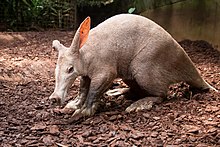
Back Erdvark Afrikaans Eorðfearh ANG خنزير الأرض Arabic خنزير الارض ARZ আৰ্ডৱাৰ্ক Assamese Orycteropus afer AST Sperdol (Orycteropus afer) AVK Borudişli Azerbaijani یئردوْموزو AZB Erdfaggi BAR
| Aardvark Temporal range:
| |
|---|---|

| |
| Aardvark in the Bushveld, Limpopo | |

| |
| At Royal Burgers' Zoo, Arnhem, Netherlands | |
| Scientific classification | |
| Domain: | Eukaryota |
| Kingdom: | Animalia |
| Phylum: | Chordata |
| Class: | Mammalia |
| Order: | Tubulidentata |
| Family: | Orycteropodidae |
| Genus: | Orycteropus |
| Species: | O. afer
|
| Binomial name | |
| Orycteropus afer (Pallas, 1766)
| |
| Subspecies | |
|
See text | |

| |
| Aardvark range | |

Aardvarks (/ˈɑːrdvɑːrk/ ARD-vark; Orycteropus afer) are medium-sized, burrowing, nocturnal mammals native to Africa.[2][3] Aardvarks are the only living species of the family Orycteropodidae and the order Tubulidentata.[4][5] They have a long proboscis, similar to a pig's snout, which is used to sniff out food.
They are afrotheres, a clade that also includes elephants, manatees, and hyraxes.
They are found over much of the southern two-thirds of the African continent, avoiding areas that are mainly rocky. Nocturnal feeders, aardvarks subsist on ants and termites by using their sharp claws and powerful legs to dig the insects out of their hills. Aardvarks also dig to create burrows in which to live and rear their young.
- ^ Taylor, A.; Lehmann, T. (2015). "Orycteropus afer". IUCN Red List of Threatened Species. 2015: e.T41504A21286437. doi:10.2305/IUCN.UK.2015-2.RLTS.T41504A21286437.en. Retrieved 12 November 2021.
- ^ Hoiberg 2010, pp. 3–4
- ^ "Aardvark, n." Dictionary of South African English. Dictionary Unit for South African English, 2018. 26 February 2019.
- ^ Schlitter 2005, p. 86
- ^ Cite error: The named reference
EoMwas invoked but never defined (see the help page).
